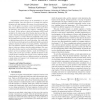210 search results - page 22 / 42 » A functional hierarchical organization of the protein sequen... |
BMCBI
2008
13 years 7 months ago
2008
Background: Structural alignment is an important step in protein comparison. Well-established methods exist for solving this problem under the assumption that the structures under...
BMCBI
2008
13 years 7 months ago
2008
Background: Recent approaches for predicting the three-dimensional (3D) structure of proteins such as de novo or fold recognition methods mostly rely on simplified energy potentia...
BMCBI
2010
13 years 7 months ago
2010
Background: Establishing the relationship between an organism's genome sequence and its phenotype is a fundamental challenge that remains largely unsolved. Accurately predict...
BMCBI
2007
13 years 7 months ago
2007
Background: In recent years, RNA molecules that are not translated into proteins (ncRNAs) have drawn a great deal of attention, as they were shown to be involved in many cellular ...
ICCAD
2009
IEEE
13 years 5 months ago
2009
IEEE
Computational protein design can be formulated as an optimization problem, where the objective is to identify the sequence of amino acids that minimizes the energy of a given prot...


